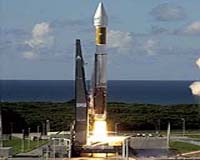 |
Paris, France (ESA) Oct 29, 2009 ESA's SMOS (Soil Moisture and Ocean Salinity) and Proba-2 (PRoject for OnBoard Autonomy) satellites are scheduled for launch on Monday 2 November at 02:50 CET on a Russian Rockot launcher from the Plesetsk cosmodrome in northern Russia. SMOS, ESA's water mission, is the first satellite designed both to map sea surface salinity and monitor soil moisture on a global scale, thus contributing to better understanding of the Earth's water cycle. Proba-2 will perform in-orbit demonstration of 17 advanced satellite technologies, solar observation experiments and plasma environment studies. The main launch event for SMOS and Proba-2 will be held at ESA's ESRIN establishment in Frascati, Italy. ESA senior management and programme specialists will be on hand to give explanations and interviews. Live TV transmission of the launch will provide quality pictures to broadcasters from Plesetsk and from mission control rooms at CNES/Toulouse in France and at ESA's Redu ground station in Belgium Share This Article With Planet Earth
Related Links ESA TV SMOS Proba-2 Launch Pad at Space-Travel.com
 Super Heavy EEVLs As Replacement Of ARES 1 And ARES 5
Super Heavy EEVLs As Replacement Of ARES 1 And ARES 5Prague, Czech Republic (SPX) Oct 27, 2009 I think that the US Space Program needs very much to liberate itself from the heritage of the STS, first of all from SRB and from huge LOX/LH2 tanks. Dry mass of such tank of ARES 5, including 6 engines RS 68, amounts at least 65.000 kg and such dead mass will receive almost orbital velocity which constitutes a big loss of the fuel. The Augustine Commission has outlined the most effective ... read more |
|
| The content herein, unless otherwise known to be public domain, are Copyright 1995-2009 - SpaceDaily. AFP and UPI Wire Stories are copyright Agence France-Presse and United Press International. ESA Portal Reports are copyright European Space Agency. All NASA sourced material is public domain. Additional copyrights may apply in whole or part to other bona fide parties. Advertising does not imply endorsement,agreement or approval of any opinions, statements or information provided by SpaceDaily on any Web page published or hosted by SpaceDaily. Privacy Statement |